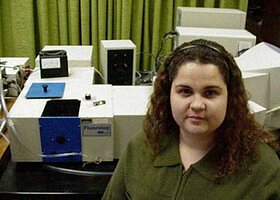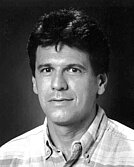New Methods to Detect Chlorinated Organic Pollutants in Water

Andrea Arruda is a Ph.D. student in the Department of Chemistry at North Dakota State University. Andrea’s research is focused on developing methods of analysis of organic pollutants by solid-phase extraction luminescence spectroscopy. Andrea is from Brasilia, Brazil. She got her M.S. in analytical chemistry from University of Brasilia. After she completes her Ph.D. she would like to continue to do research and teach at a university.
Fellow: Andrea F. Arruda, Department of Chemistry, NDSU
Advisor: Andres D. Campiglia, Assistant Professor of Chemistry, NDSU
Matching Support: NDSU central administration
Degree Progress: Ph.D. completion expected by December 2001.
Cooperator: Dakota Technologies, Inc., Fargo, ND
New Methods to Detect Chlorinated Organic Pollutants in Water
Polychlorinated biphenyls (PCB) and polychlorinated dibenzofurans (PCDF) are organic pollutants that can occur in surface, ground and drinking water.
The initial objective of this project was to provide a rapid, simple and cost effective screening method for determining total PCBs and PCDFs in water samples. The objective was accomplished coupling solid-liquid extraction (SLE) and room temperature phosphorimetry (RTP). The method includes a three-step sample procedure, namely water extraction, application of phosphorescence enhancers to the extraction membrane, and direct RTP detection on the extracting substrate. The water sample (10-100 mL) is processed through an octadecyl extraction membrane with a syringe. The excess of water is removed from the membrane applying positive pressure to the syringe. 5 mL of phosphorescence enhancer is applied to the extracting substrate previous to phosphorescence detection. RTP is performed with a commercial spectrophosphorimeter under a nitrogen flow. Total analysis time varies from 8 to 10 minutes per sample. Limits of detection with 100mL of water sample were estimated at the parts-per-trillion level (10-12g.mL-1). Lower limits of detection are obtainable with larger water volumes. Environmental pollutants commonly encountered in water samples do not interfere with the screening method.
As an alternative to achieve specific compound identification, time-resolved laser-excited Shpol’skii spectrometry is being investigated. PCB and PCDBF are eluted from the extraction membrane using an n-alkane, which is frozen by sample vial immersion into liquid nitrogen (77K) or liquid helium (4.2K). The spectroscopy is directly performed from the frozen matrix using a fiber optic probe. This approach provides excellent reproducibility of measurements (2-5%) and relies on a rapid and simple experimental procedure. Promising preliminary results indicate the potential for specific compound identification at the parts-per-trillion level with no matrix interference.
Publications
A. F. Arruda and A. D. Campiglia, 1999. Determination of trace levels of polychlorinated biphenyls on reversed phase octadecyl bonded silica phases. Anal. Chim. Acta, 386, 271-280.
E. D. Hagestuen, A. F. Arruda and A. D. Campiglia, 2000. On the improvement of solid-phase extraction and room-temperature phosphorimetry for the analysis of polyciclic aromatic hydrocarbons in water samples. Talanta, 52(4), 727-737.
A. F. Arruda and A. D. Campiglia. 2000. Screening potential of solid-phase extraction room temperature phosphorimetry for the analysis of polychlorinated dibenzofurans in water samples. Environ. Sci. Technol., 34(23), 4982-4988.

Andres D. Campiglia
Chemistry, NDSU


